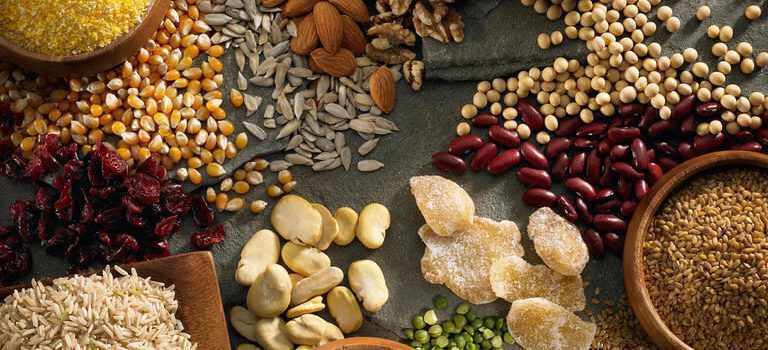Celiac Disease. Celiac disease is an inherited autoimmune disease with symptoms triggered by the consumption of gluten. Gluten is the name for specific proteins found in wheat, barley, and rye. In celiac disease, the body's immune system reacts negatively to gluten, which causes damage to the lining of the small intestine and poor absorption of vitamins and minerals. It is estimated that celiac disease may affect as many as 300,000 Canadians, although many have not been diagnosed.
How is celiac disease diagnosed? A diagnosis of celiac disease can sometimes be difficult because the symptoms are similar to those of other conditions, such as irritable bowel syndrome (IBS), chronic fatigue syndrome, stomach ulcers, and fibromyalgia. In some cases, individuals may consult with several medical professionals and have the disease for many years before finally being diagnosed. Diagnosis of celiac disease starts with a blood test. Following a positive blood test, a tissue sample (biopsy) of the intestine is done to confirm the diagnosis.
Symptoms and treatment. Without treatment, people with celiac disease can have long-term poor health, and may experience many unpleasant symptoms, including fatigue, digestive problems, nausea, constipation, weight loss, bone and joint pain, depression, and migraine headaches. In addition, celiac disease can cause higher risk for osteoporosis, infertility, and cancers of the gastrointestinal tract.
Currently, the only treatment for celiac disease is maintaining a strict gluten-free diet for life. A gluten-free diet will allow the small intestine to heal and correct many of the symptoms and nutritional deficiencies caused by gluten.
The gluten-free diet. Since a gluten-free diet is the only treatment for celiac disease, it's critical that people with this disease understand how to identify foods that contain gluten. In general, they must avoid all forms of wheat (including couscous, bulgur, spelt and kamut), barley, rye and triticale.
This includes all foods and ingredients that contain these grains. Careful label reading and knowledge of potential hidden sources of gluten are essential for people who have celiac disease. A registered dietitian can educate people on food choices, label reading, and meal planning for celiac disease. In addition, comprehensive resources are available to help people identify gluten-containing foods (see "Your Best Resources for Gluten-Free Food Information" below).
Foods people who have celiac disease can enjoy. The good news is that there are so many gluten-free grains and starches that can be enjoyed by individuals with celiac disease – these include:
- Rice
- Corn
- Potato flour / starch
- Buckwheat
- Pure oats (oats that are uncontaminated with gluten-containing grains)
- Legume flours (beans, chickpea, peas, lentil)
- Millet
- Quinoa
- Sweet potato flour
- Sorghum
- Tapioca
Is gluten-free healthier? For people with celiac disease, a gluten-free diet is essential. For those who do not have celiac disease or gluten sensitivity, a gluten-free diet is not necessarily healthier than a diet containing gluten. Here are a few things to consider if you're planning to go gluten-free when it's not medically necessary:
Fewer whole grain options: Common whole grain options in the North American diet, such as whole grain baked goods, cereals, pasta, and barley, contain gluten. These whole grains provide important nutrients including B vitamins and fibre. Eliminating gluten means a significant reduction in delicious and nutritious whole grain options.
Gluten-free may mean higher calories: A gluten-free diet is not a weight-loss diet. In fact, a comparison of nutrition facts tables will often show higher amounts of calories and fat in gluten-free packaged foods compared to their conventional counterparts. Gluten-free products often require more starches and fats to taste and feel like wheat-containing foods. Switching to a gluten-free diet requires careful attention to food labels to avoid weight gain.
DISCLAIMER
The information provided on this list is based solely on manufacturer package claims. We will not be liable for any manufacturer errors, listing errors, individual reactions to any products, nor can we guarantee the absence of cross contamination. Products are identified as gluten free based on a gluten free claim on the packaged product. Some products listed are made in facility that also contains gluten containing ingredients. Product information and ingredients can change without notice. Therefore, at the time of purchase, always read the label and/or contact the manufacturer if you have any questions. Please keep in mind that there are products available in this category that may not be shown on our list. Product availability may also be limited to specific store locations. The information provided is not a substitute for professional medical advice. If you have specific needs, please see your health care provider.
Your Best Resources for Gluten-Free Food Information
For more information on gluten-free and gluten-containing foods, please consult the following resources:
- Canadian Celiac Association – Food Choices: http://www.celiac.ca/?page_id=299
- Canadian Celiac Association – What Not to Eat: http://www.celiac.ca/?page_id=302
- Pocket Dictionary – Acceptability of Foods & Food Ingredients for the Gluten-Free Diet, 2012 edition, Canadian Celiac Association: This pocket-sized dictionary helps people with celiac disease and gluten sensitivity understand food ingredients and identify foods containing gluten.
- Gluten-Free Diet – A Comprehensive Resource Guide, by Shelley Case, RD: The latest version of this comprehensive guide includes over 3,100 gluten-free and specialty foods listed by company and product names. It can also be found at http://glutenfreediet.ca/.
Our References
The above information was summarized from Celiac Disease – The Gluten Connection, Health Canada. For the full article please visit: http://www.hc-sc.gc.ca/fn-an/alt_formats/hpfb-dgpsa/pdf/securit/gluten_conn-lien_gluten-eng.pdf. Also referenced was Celiac Disease – Still Vastly Under-Diagnosed, Shelley Case, Case Nutrition Consulting, Inc. For the full article please visit: http://www.celiac.ca/pdfs/Undiagnosed_Celiac.pdf.







